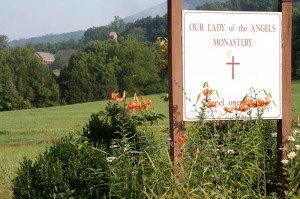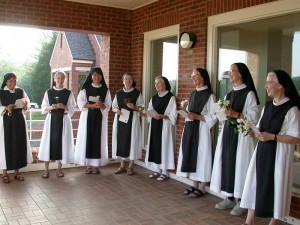How does your community contribute to the good of the world?
It provides a credible witness that it is possible to live, and live fruitfully, in accordance with the gospel, in an undivided love for Christ, and in sacrifice and compassion for all the human family.
What is the basic truth underlying the monastic lifestyle?
God is worthy of the total gift of the human heart, and calls some persons to make this total gift, and to be satisfied with nothing else.
Why is Our Lady of the Angels called a monastery instead of a convent?
The word convent is commonly used now to designate a residence of Sisters who engage in an active apostolate. The word monastery is a more ancient term, used to designate the dwelling place of those who lead a monastic life, both men and women – that is, a life of worship and work within the monastery environment as their apostolate.
How many Sisters are there, and where do they come from?
At present we are 13 Sisters – hailing from all over the US and beyond. We come from New York, California, Massachusetts, Minnesota, South Carolina, Texas, Spain, Haiti, Labrador and India!
Could you explain your apostolate of worship and work?
Fidelity to the monastic way of life is closely related to zeal for the Kingdom of God and for the salvation of the whole human
race. Nuns bear this apostolic concern in their hearts. It is the contemplative life itself that is their way of participating in the mission of Christ and his Church and of being part of the local church. Through different forms of hospitality, we share the joy and beauty of the treasure granted to us, and support and encourage those who desire a more profound encounter with God.
How would you explain monastic life to a contemporary man or woman?
Like all of the Christian experience, monastic life is full of mysterious paradoxes. It is an encounter with the mystery of God; it is also an encounter with human weakness, failure, and the need for forgiveness.
It has been called a quest for the absolute and is built upon high ideals; it is lived out in the midst of everyday realities and unspectacular circumstances.
It shares in Jesus’ risen life, but only through sharing in his cross.
It promises and bestows fulfillment and joy, but only through the self-emptying of love, and the pain implicit in all true
growth.
Many essential elements go to make it up, but there is a time and a place for each aspect; they must be kept in a dynamic balance.
It is firmly rooted in the life of earth; it stretches out toward the eternal life to come.



 Find us on Facebook
Find us on Facebook Follow us on Pinterest
Follow us on Pinterest